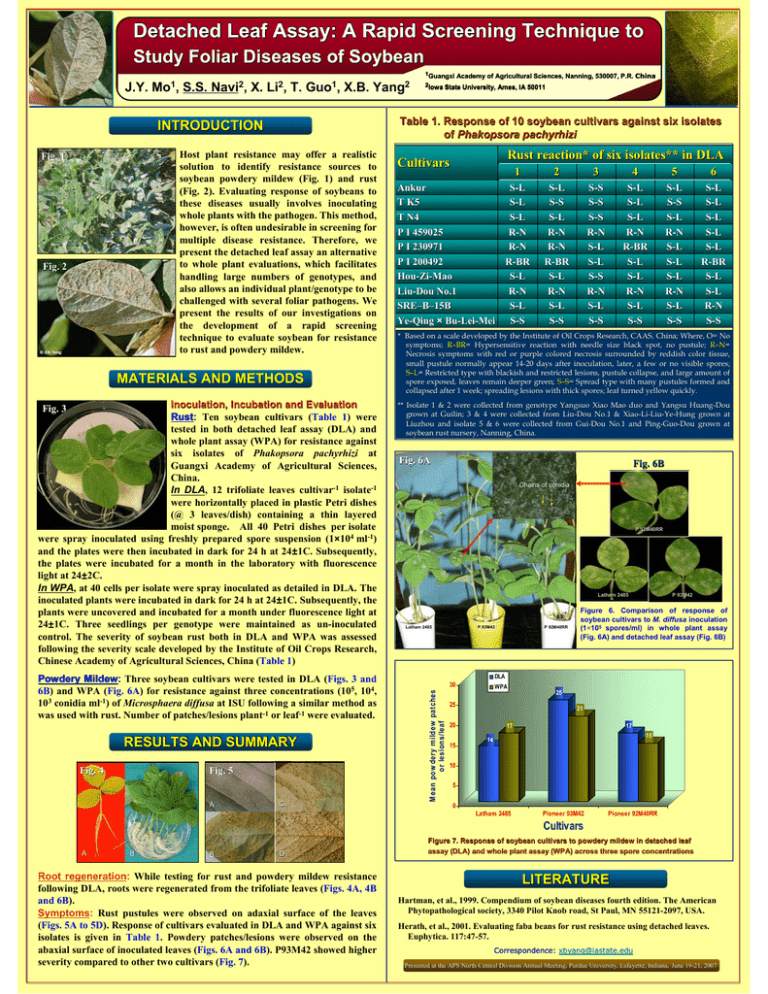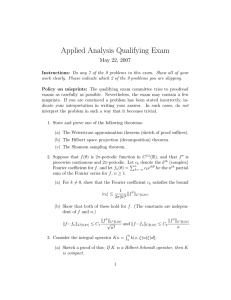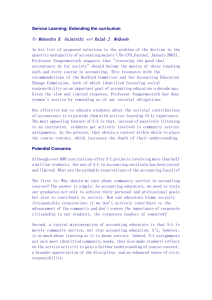Detached Leaf Assay: A Rapid Screening Technique to
advertisement

Detached Leaf Assay: A Rapid Screening Technique to Study Foliar Diseases of Soybean J.Y. Mo1, S.S. Navi2, X. Li2, T. Guo1, X.B. Yang2 MATERIALS AND METHODS Inoculation, Incubation and Evaluation Rust: Rust Ten soybean cultivars (Table 1) were tested in both detached leaf assay (DLA) and whole plant assay (WPA) for resistance against six isolates of Phakopsora pachyrhizi at Guangxi Academy of Agricultural Sciences, China. In DLA, 12 trifoliate leaves cultivar-1 isolate-1 were horizontally placed in plastic Petri dishes (@ 3 leaves/dish) containing a thin layered moist sponge. All 40 Petri dishes per isolate were spray inoculated using freshly prepared spore suspension (1×104 ml-1) and the plates were then incubated in dark for 24 h at 24±1C. Subsequently, the plates were incubated for a month in the laboratory with fluorescence light at 24±2C. In WPA, at 40 cells per isolate were spray inoculated as detailed in DLA. The inoculated plants were incubated in dark for 24 h at 24±1C. Subsequently, the plants were uncovered and incubated for a month under fluorescence light at 24±1C. Three seedlings per genotype were maintained as un-inoculated control. The severity of soybean rust both in DLA and WPA was assessed following the severity scale developed by the Institute of Oil Crops Research, Chinese Academy of Agricultural Sciences, China (Table 1) Fig. 3 Powdery Mildew: Mildew Three soybean cultivars were tested in DLA (Figs. 3 and 6B) and WPA (Fig. 6A) for resistance against three concentrations (105, 104, 103 conidia ml-1) of Microsphaera diffusa at ISU following a similar method as was used with rust. Number of patches/lesions plant-1 or leaf-1 were evaluated. RESULTS AND SUMMARY Fig. 5 Fig. 4 A C Rust reaction* of six isolates** in DLA Cultivars 1 Ankur S-L T K5 S-L T N4 S-L P I 459025 R-N P I 230971 R-N P I 200492 R-BR HouS-L Hou-ZiZi-Mao LiuR-N Liu-Dou No.1 SRE– S-L SRE–B–15B YeYe-Qing × BuBu-LeiLei-Mei S-S ©Navi 2 3 4 5 6 S-L S-S S-L R-N R-N R-BR S-L R-N S-L S-S S-S S-S S-S R-N S-L S-L S-S R-N S-L S-S S-L S-L S-L R-N R-BR S-L S-L R-N S-L S-S S-L S-S S-L R-N S-L S-L S-L R-N S-L S-S S-L S-L S-L S-L S-L R-BR S-L S-L R-N S-S * Based on a scale developed by the Institute of Oil Crops Research, Research, CAAS, China; China; Where, O= No symptoms; R–BR= BR= Hypersensitive reaction with needle size black spot, no pustule; pustule; R–N= Necrosis symptoms with red or purple colored necrosis surrounded by reddish color tissue, small pustule normally appear 1420 days after inoculation, later, a few or no visible spores; 14 S–L= Restricted type with blackish and restricted lesions, pustule collapse, and large amount of spore exposed, leaves remain deeper green; S–S= Spread type with many pustules formed and collapsed after 1 week; spreading lesions with thick spores; leaf leaf turned yellow quickly. ** Isolate 1 & 2 were collected from genotype Yangsuo Xiao Mao duo duo and Yangsu HuangHuang-Dou grown at Guilin; 3 & 4 were collected from LiuLiu-Dou No.1 & XiaoXiao-LiLi-LiuLiu-YeYe-Hung grown at Liuzhou and isolate 5 & 6 were collected from GuiDou No.1 and PingGuoDou grown at Gui Ping Guo soybean rust nursery, Nanning, China. Fig. 6A Fig. 6B Chains of conidia x40 P 92M40RR P 93M42 Latham 2485 Latham 2485 P 93M42 P 92M40RR Figure 6. Comparison of response of soybean cultivars to M. diffusa inoculation (1×105 spores/ml) in whole plant assay (Fig. 6A) and detached leaf assay (Fig. 6B) DLA 30 M ean pow dery m ildew patches or lesions/leaf Host plant resistance may offer a realistic solution to identify resistance sources to soybean powdery mildew (Fig. 1) and rust (Fig. 2). Evaluating response of soybeans to these diseases usually involves inoculating whole plants with the pathogen. This method, however, is often undesirable in screening for multiple disease resistance. Therefore, we present the detached leaf assay an alternative to whole plant evaluations, which facilitates handling large numbers of genotypes, and also allows an individual plant/genotype to be challenged with several foliar pathogens. We present the results of our investigations on the development of a rapid screening technique to evaluate soybean for resistance to rust and powdery mildew. Fig. 2 Iowa State University, Ames, IA 50011 Table 1. Response of 10 soybean cultivars against six isolates of Phakopsora pachyrhizi INTRODUCTION Fig. 1 1Guangxi Academy of Agricultural Sciences, Nanning, 530007, P.R. China 2Iowa State University, Ames, IA 50011 WPA 25 25 21 20 17 17 15 14 15 10 5 0 Latham 2485 Pioneer 93M42 Pioneer 92M40RR Cultivars A B B D Root regeneration: While testing for rust and powdery mildew resistance following DLA, roots were regenerated from the trifoliate leaves (Figs. 4A, 4B and 6B). Symptoms: Rust pustules were observed on adaxial surface of the leaves (Figs. 5A to 5D). Response of cultivars evaluated in DLA and WPA against six isolates is given in Table 1. Powdery patches/lesions were observed on the abaxial surface of inoculated leaves (Figs. 6A and 6B). P93M42 showed higher severity compared to other two cultivars (Fig. 7). Figure 7. Response of soybean cultivars to powdery mildew in detached detached leaf assay (DLA) and whole plant assay (WPA) across three spore concentrations concentrations LITERATURE Hartman, et al., 1999. Compendium of soybean diseases fourth edition. The American Phytopathological society, 3340 Pilot Knob road, St Paul, MN 55121-2097, USA. Herath, et al., 2001. Evaluating faba beans for rust resistance using detached leaves. Euphytica. 117:47-57. Correspondence: xbyang@iastate.edu Presented at the APS North Central Division Annual Meeting, Purdue Purdue University, Lafayette, Indiana, June 1919-21, 2007







